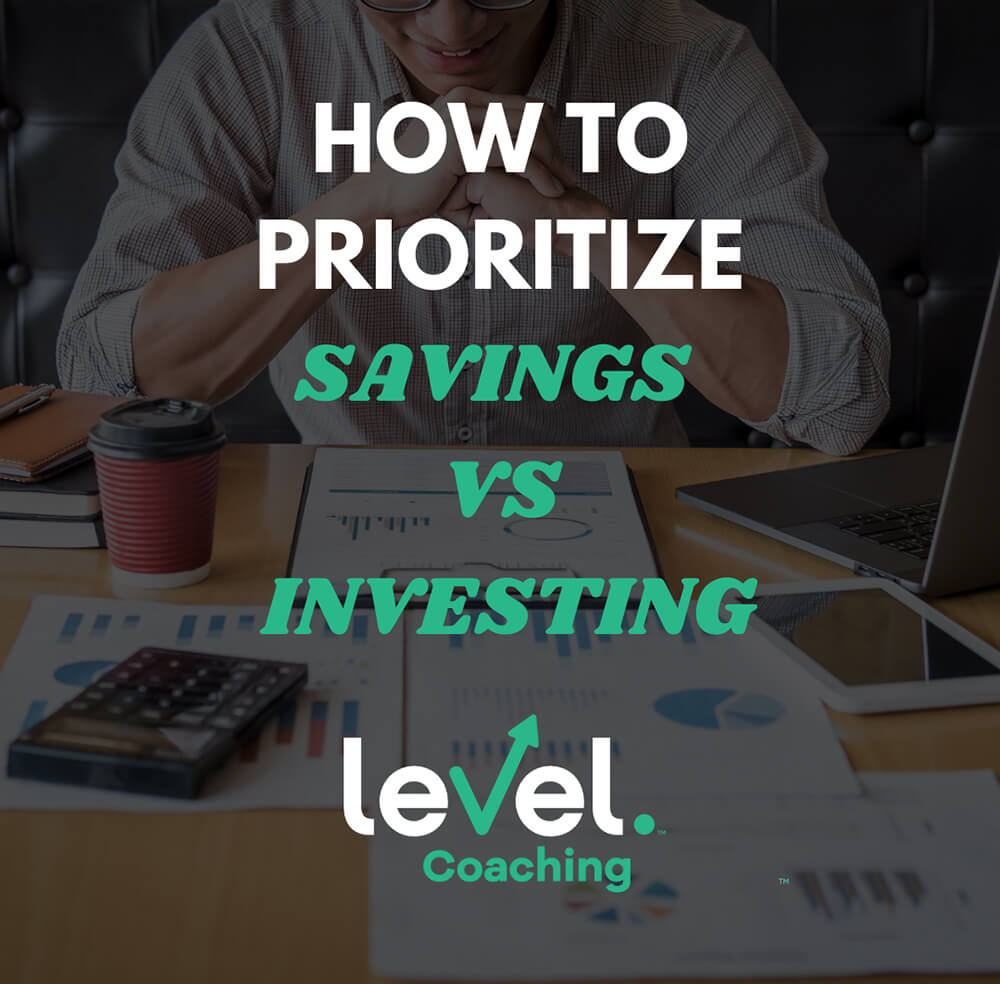
11 Oct How to Prioritize Between Savings and Investing Goals
At Level Coaching, we’re committed to helping you break free from debt and achieve financial independence. One of the biggest decisions you’ll face on this journey is whether to focus on saving or investing your money. Both are essential to building a secure financial future, but knowing when to prioritize each can make all the difference in reaching your goals efficiently. By understanding the right approach for your unique situation, you can create a balanced strategy that sets you up for long-term success.
Let’s break down how to determine whether your money belongs in a savings account or an investment strategy based on different financial goals.

1. Build Your Emergency Fund First
Before diving into investing, your first priority should be building an emergency fund. This fund acts as your safety net for life’s unexpected twists, whether it’s an unplanned medical bill or a period of unemployment. Having an emergency fund means you can handle these challenges without leaning on credit cards and accumulating more debt.
Since you may need these funds quickly, it’s best to keep your emergency savings in a high-yield savings account, which offers immediate access without penalty. While the interest earned is modest, the primary purpose of an emergency fund is accessibility, not growth. Once you have this in place, you’ll have more flexibility to focus on your other financial goals.
2. Saving for Short-Term Purchases
If you’re saving for something within the next year, like a car, home, or vacation, it’s generally wiser to keep your funds in a savings account. While investing might offer higher returns, short-term market fluctuations can pose a risk if you need to access the money quickly.
By keeping your money in a savings account, you ensure that it’s readily available when the time comes to make your purchase—without the risk of having to sell investments at a loss.
3. Medium-Term Financial Goals
For goals that fall in the 3-5 year range—such as saving for a home down payment or another major life event—you might consider a combination of savings and investing. The key here is how flexible your timeline is. If you need the money by a specific date, you’ll want to lean more toward savings or low-risk investments. However, if your timeline is flexible, you can explore higher-return investment options, knowing that you have time to weather any market volatility.
Ask yourself:
- How specific is my timeline? If you’re aiming to buy a house in five years but could wait seven, you may take on more investment risk. But if your goal is fixed, prioritize lower-risk savings vehicles.
- How aggressive do I need to be? If growing your savings is essential to reaching your goal, a slightly riskier investment strategy may be appropriate. If not, you might focus on safer options that preserve your capital.

4. Investing for Retirement
When it comes to retirement, investing should always take precedence over saving. Retirement is a long-term goal, allowing you to take advantage of the market’s potential for growth over time. The earlier you start, the more time your money has to compound and grow.
Be sure to maximize any employer-sponsored retirement plans, like a 401(k), and take advantage of tax-deferred accounts like an IRA (Individual Retirement Account). These vehicles offer potential for growth that a traditional savings account simply can’t match.
5. Planning for Your Child’s Future
If you’re thinking about long-term goals for your child’s education, investing is usually the smarter move. One popular option is a 529 savings plan, which allows you to invest after-tax dollars that grow tax-free when used for qualified educational expenses. Another option might be Treasury Bonds or a Coverdell Education Savings Account, both of which offer different levels of security and growth potential.
By making investments that align with your timeline and risk tolerance, you’re setting your child up for success without putting undue stress on your finances.
Making the Right Choice for You
Deciding whether to prioritize saving or investing is personal, and there’s no one-size-fits-all solution. At Level Coaching, our financial coaches can help you create a personalized strategy based on your specific goals, needs, and financial situation. Whether you’re just starting to build your emergency fund or planning for long-term retirement, we’ll guide you toward the right path to financial independence.
Ready to take the next step? Give us a call today and let’s start building a future where you’re not just debt-free, but financially empowered.

